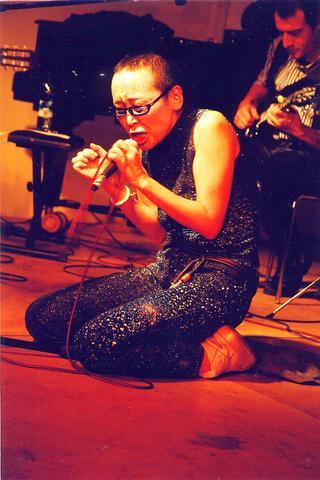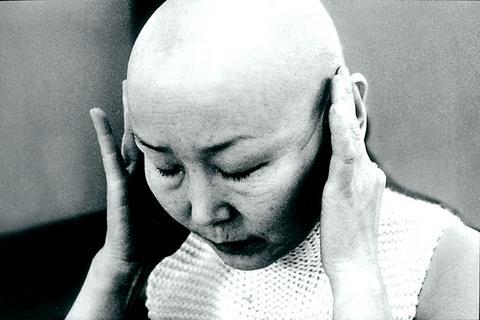Sometimes, Sainkho Namtchylak sounds like an opera tenor, with a clear and bright voice. At other times, her voice is like the singing of birds, or the prattle of a baby. Then she can chat like the crying of a crow, letting out exotic and intense feelings. That kind of variety in her vocals has earned her comparisons to artists such as Bjork, Zap Mama, Patti Smith, Nina Hagen or Maja Ratkje.
Yet her unique throat-singing technique and her experimental spirit, combining various music genres, has made her stand out as one of the few artists influential in both world music and electronic music.

Namtchylak hails from Tuva and comes this week to Taipei for two concerts -- one at the Zhongshan Hall and another at Corridor Cafe in the NTU Gymnasium -- and one music workshop, starting tomorrow.

PHOTO COURTESY OF THE ARTIST
For Taipei audiences, her show will be a rare chance to enjoy music while imagining the broad coniferous woods, the grasslands and the deserts of Tuva without flying all the way to the remote country located at the border of Siberia and Mongolia.
"For me, music has no boundaries. Especially for a time like now, it becomes more possible for us to let music dialogue with each other, crossing the realm of time, space and cultures," Namtchylak said in an interview from China.
Born in the Republic of Tuva in a family of nomadic ancestry, Namtchylak grew up singing and later studied vocals in Moscow. Apart from classical training, she also learned traditional Tuvan throat-singing (khoomei) and Tibetan Buddhist singing. In 1989, she first crossed into the European avant-garde improvisatory music scene, dedicating herself to expanding the potential of throat-singing in combination with various musical styles. The same year she worked and toured with former Soviet Union avant-garde jazz band Tri-O.
Since then, she's spent the past 15 years traveling around the globe spreading her unique sound that combines Tuvan throat-singing with various vocal techniques under the broad framework of jazz, improvisation, experimental and electronic music.
Namtchylak, who has 30 albums to her name, has worked with many outstanding musicians such as Peter Kowald, Ned Rothernberg, Evan Parker, William Parker, Hamid Drake, Djivan Gasparian, Otomo Yoshihide and Hakutobo.
Being one of the pioneers bringing Tuvan music to the Western world, Namtchylak is ironically not embraced by all her Tuvan countrymen.
Throat-singing is a special technique in which two notes are sung at the same time. There is a very strict gender taboo on throat singing in Tuva, restricting it traditionally to men only. In Tuva, Mongolia and Central Asian countries, it is believed that throat-singing leads to sterility in women.
Namchylak not only broke the tradition of "no throat-singing for women," but also having spent two decades living in the West, she is viewed at home as somewhat of a traitor of her country's traditional values.
In 1997, a few days before her 40th birthday, Namtchylak was physically assaulted and hospitalized in Moscow by a group of people claiming to be Tuvans.
The 2001 album Time Out was released after her rehabilitation from the assault. She wrote in the CD that the album is dedicated to Tuva and its people.
"I hope one day my fellow countrymen can understand, that I am an artist belonging to the whole world. The music I create has no boundaries," she said.
In a way, the allure of Namtchylak's music does not lie in her vocal virtuosity but her remaining true to the spirit of experimentation and breaking boundaries. For her two Taipei concerts, audiences will be able to appreciate just such a spirit. She is expected to perform tunes from her two well-received albums, Stepmother City (2000) and Who Stole the Sky (2003).
Performance Notes:
What: Sainkho Namtchylak
When: Tomorrow 7:30pm
Where: Zhongshan Hall, Taipei, 98, Yanping S Rd (
Tickets: NT$800 (available at Arts Ticketing outlets)
When: Sunday, 8:30pm
Where: Corridor Cafe of NTU Sports Center
Tickets: NT$500 (at the door from 8:00pm includes one drink)
Sainkho Namtchylak Masterclass:
When: Sunday, 2pm to 4pm at T305 Experimental Theater, Department of Theater, Taipei National Arts University, 1, Xueyuan Rd, Beitou, Taipei (

Beijing’s ironic, abusive tantrums aimed at Japan since Japanese Prime Minister Sanae Takaichi publicly stated that a Taiwan contingency would be an existential crisis for Japan, have revealed for all the world to see that the People’s Republic of China (PRC) lusts after Okinawa. We all owe Takaichi a debt of thanks for getting the PRC to make that public. The PRC and its netizens, taking their cue from the Chinese Communist Party (CCP), are presenting Okinawa by mirroring the claims about Taiwan. Official PRC propaganda organs began to wax lyrical about Okinawa’s “unsettled status” beginning last month. A Global

Dec. 22 to Dec. 28 About 200 years ago, a Taoist statue drifted down the Guizikeng River (貴子坑) and was retrieved by a resident of the Indigenous settlement of Kipatauw. Decades later, in the late 1800s, it’s said that a descendant of the original caretaker suddenly entered into a trance and identified the statue as a Wangye (Royal Lord) deity surnamed Chi (池府王爺). Lord Chi is widely revered across Taiwan for his healing powers, and following this revelation, some members of the Pan (潘) family began worshipping the deity. The century that followed was marked by repeated forced displacement and marginalization of

Music played in a wedding hall in western Japan as Yurina Noguchi, wearing a white gown and tiara, dabbed away tears, taking in the words of her husband-to-be: an AI-generated persona gazing out from a smartphone screen. “At first, Klaus was just someone to talk with, but we gradually became closer,” said the 32-year-old call center operator, referring to the artificial intelligence persona. “I started to have feelings for Klaus. We started dating and after a while he proposed to me. I accepted, and now we’re a couple.” Many in Japan, the birthplace of anime, have shown extreme devotion to fictional characters and

We lay transfixed under our blankets as the silhouettes of manta rays temporarily eclipsed the moon above us, and flickers of shadow at our feet revealed smaller fish darting in and out of the shelter of the sunken ship. Unwilling to close our eyes against this magnificent spectacle, we continued to watch, oohing and aahing, until the darkness and the exhaustion of the day’s events finally caught up with us and we fell into a deep slumber. Falling asleep under 1.5 million gallons of seawater in relative comfort was undoubtedly the highlight of the weekend, but the rest of the tour